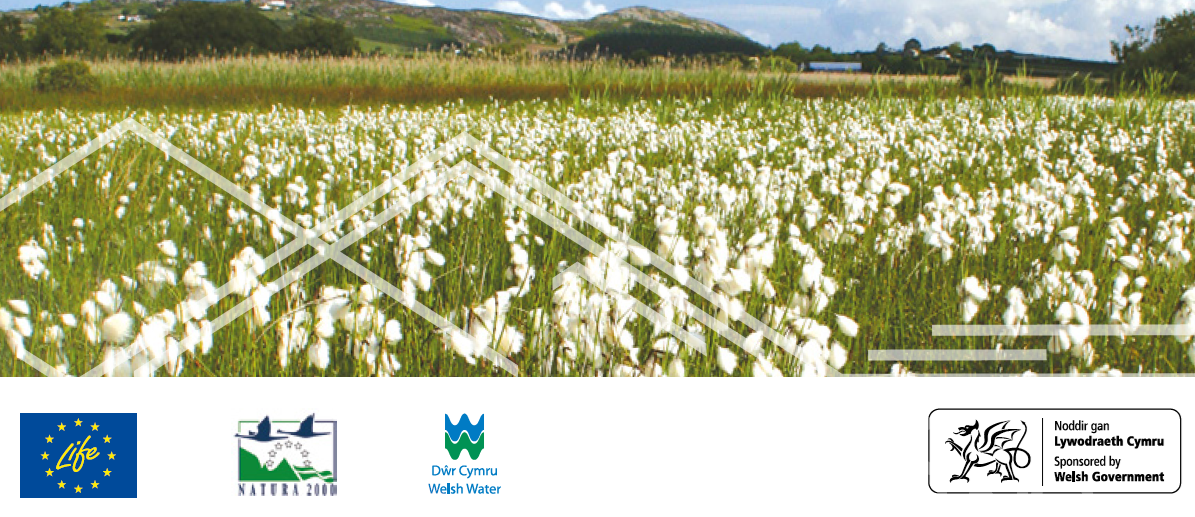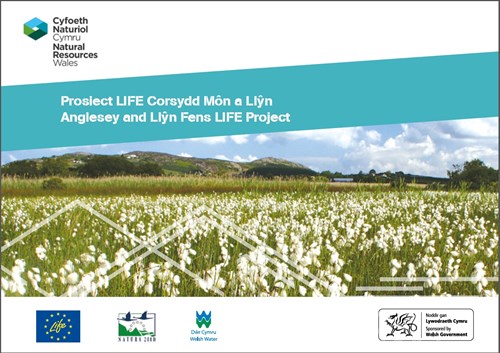Anglesey and Llŷn Fens LIFE Project

About the project
The Anglesey and Llŷn Fens LIFE Project makes it easy to see how natural resources management can be relatively simple ideas that can easily be incorporated into the work that we do.
EC Life+ project funding has been critical, it has made it possible for Natural Resources Wales, Welsh Government and Welsh Water to make a difference for nature conservation, and in terms of delivering a natural resource management approach to these fens and their surroundings on Anglesey and the Llŷn peninsula.
It's only been possible to deliver the project successfully by listening to, and by working with the people who live and work in the catchments.
What are fens and why are they special?
A fen is a type of wetland fed by mineral-rich water. Fens support a wide range of animals and plants, many of which are tall marsh plants growing closely together such as rushes, sedges or blankets of wildflowers. One acre of fen in good condition is as rare as seeing an osprey in your garden.
The fens on Anglesey and Llŷn get their water from springs that are rich in calcium and it’s this mixing of alkaline and acid that makes them so special, and so rare.
In the past they were the lifeblood of the local people but in the last few decades we have become separated from them and they have suffered from our neglect. Anglesey and Llŷn Fens Special Areas of Conservation (SACs) combined are the most significant and extensive concentration of rich fen habitat in Wales and western Britain.
What are the problems?
Dereliction
The fens have suffered from dereliction. The main reason for this is lack of grazing. All of the fens need to be more actively grazed by animals such as cattle and ponies.
Grazing has declined due to more intense, modern agricultural practices that have steered away from traditional rough grazing. Animal bedding, foodstuffs and roofing thatch are no longer harvested adding to the trend of neglect. Fire was historically used to remove litter and encourage bursts of growth but this practice has also dwindled.
Water quantity
Artificial drainage is very common on all of the Anglesey and Llŷn Fens. This was for peat cutting, agriculture and water from drainage schemes within the site catchments. Drainage results in water table drawdown which dries out the peat and cuts off the supply of calcium rich water to areas of precious alkaline and calcareous fen vegetation.
Water quality
All of the project sites suffer from enrichment from both diffuse and point sources. Sources include inorganic fertilisers, organic manure, slurry and the disposal of abattoir and other organic waste adjacent to the sites as well as sewage
What have we done?
- Demonstrated that conservation and farming can work very well together
- Removed or reprofiled about 100,000 tonnes of damaged soil by carrying out probably the biggest alkaline and fen restoration projects in Europe on over 15ha of degraded peat
- Mowed and burnt well over 200ha of rank, overgrown fen
- Opened up over 500ha of land to grazing and the local economy again
- Removed over 100ha of scrub that was drying up or shading out fen
- Entered into agreements with landowners on over 200ha to get land managed in a mutually beneficial way
- Restored over 3.5km of springs, streams and seepages with the fenland that relies on their water
- Got the water levels right on over 6km of ditches – lowering and raising water levels as appropriate to ensure rare fens can thrive without impacting on neighbours’ land
- Brought over 200ha of land into direct conservation management where public access will also be improved
- Contributed to slowing down the rate at which flood water reaches flood risk areas and cleaned up millions of litres of water in our water course
- Improved the recognition of Wales as a country that can deliver internationally important conservation and restoration projects
- Worked in collaboration with international colleagues to produce a high quality children’s book and animation
- Improved the habitat of the sites and paved the way for the re-discovery of plants that haven’t been seen on the sites for over 120 years
Further information about the project
 This book has snapshots about the work that has been going on in the Anglesey and Llŷn Fens LIFE Project for the past 5 years.
This book has snapshots about the work that has been going on in the Anglesey and Llŷn Fens LIFE Project for the past 5 years.
You’ll see why the sites are important for wildlife and people, and why it's important to invest time and resources to improve the Anglesey and Llŷn Fen.
Download the Anglesey and Llŷn Fens LIFE Project summary book
Where next?
We will have a number of teams dealing with different aspects of this work in the future.
If you are interested in nutrient planning in your land near to a wetland, or if you own an SSSI where you are interested in improving it for conservation and farming get in touch.
